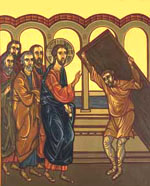Gallery of Philologists
Bishop Spyridon
c350
Bishop Spyridon had a hard life. We may skip it and come straight to the point that makes him immortal. In his history of the early Church, Sozomen, a 5th century lawyer of Constantinople, tells this story:
At an assembly of Cypriot bishops, about the year 350, Triphyllios of Ledra, a man of culture and eloquence, was addressing the assembly, and in quoting a line from the story of the Healing of the Paralytic in John 5:8, he substituted the refined term skimpous "bed" for the vulgar term krabbatos "pallet" which stood in the Gospel text. Up rose Bishop Spyridon, and indignantly called to him, in front of the whole assembly, "Are you then greater than He who said krabbatos, that you are ashamed to use His word?
Thus went one of Church history's most famous instances of the gentrification of the Bible text, and of a prompt and rightminded rebuke of that process.
It is known, to all who know such things, that the rough Greek of the Gospel of Mark is consistently paralleled by smoother Greek in Matthew and Luke. One instance of that relationship is the Healing of the Paralytic, where Mark has krabbatos and the other two Gospels have something else: Matthew klinhn, and Luke klinidion. The two more genteel words here are related, but neither is the same as Triphyllios's substitute, skimpous. We may then be sure that Triphyllios is not unconsciously drawing on the Matthean or the Lukan gentrification, but improvising one of his own. To establish that is one satisfaction.
There are others. It was obvious to Spyridon, and it will be obvious to any bystander, what Triphyllion was doing. He was a snob, and as he speaks, we see the gentrification process in action. That process cannot be conceived of as going the other way. The rougher reading is original, and it was changed out of a misplaced sense of propriety. So also, then, in all probability, Matthew and Luke are improving Mark's Jesus: combing his hair, fixing up his diction, making him more presentable in the drawing rooms of the educated rich. That Mark, coming upon Matthew's and/or Luke's versions, should have changed them to something cruder, is not on the list of things that are likely to happen. So thought Hawkins, and so have thought many since his time. There has never been a convincing argument as to why they should not think so.
Then we may be decently sure that, in this passage, Mark is the earlier text, and Matthew and Luke are rewriting it for reasons of decorum. This gives the directionality statement
Mark > Matthew, Luke.
And now, if only we knew the relationship between Matthew and Luke, the entire Synoptic problem would lie, fully solved, before us. All we would have to do would be to call up the publisher, to haul it away.
The Synoptic Problem normally takes no account of John, but there John is, nothwithstanding. John has no parallels for most of the deeds of Jesus which make up much of the Synoptic material; John is abstract in the extreme. This Healing of the Paralytic incident is one of the exceptions. That John is the latest of the Four Gospels is rather easily shown, if anything at all can be shown in this business. But what is the exact relation of John to the earlier three? As far as this passage goes, the word krabbatos shows that John is here drawing on Mark, and not on either of the other two. How far may we go, in reading the four Gospels in parallel, before we encounter evidence that forces us to alter this conclusion?
Such are the little investigations which the inspiring and philologically fruitful tale of Bishop Spyridon offers to a modern mind with time on its hands.
Readings
- John Hawkins. Horae Synopticae.
- Bruce M Metzger. The Text of the New Testament. 3ed PB Oxford 1992. The story of Spyridon is quoted on p196.
- Kurt Aland (ed). Synopsis of the Four Gospels: Greek-English Edition of the Synopsis Quattuor Evangeliorum. German Bible Society 12ed 2001. This is where you do your Synoptic homework. By the time you turn the last leaf, you should have solved it.
2 Oct 2006 / Contact The Project / Exit to Gallery Index Page
